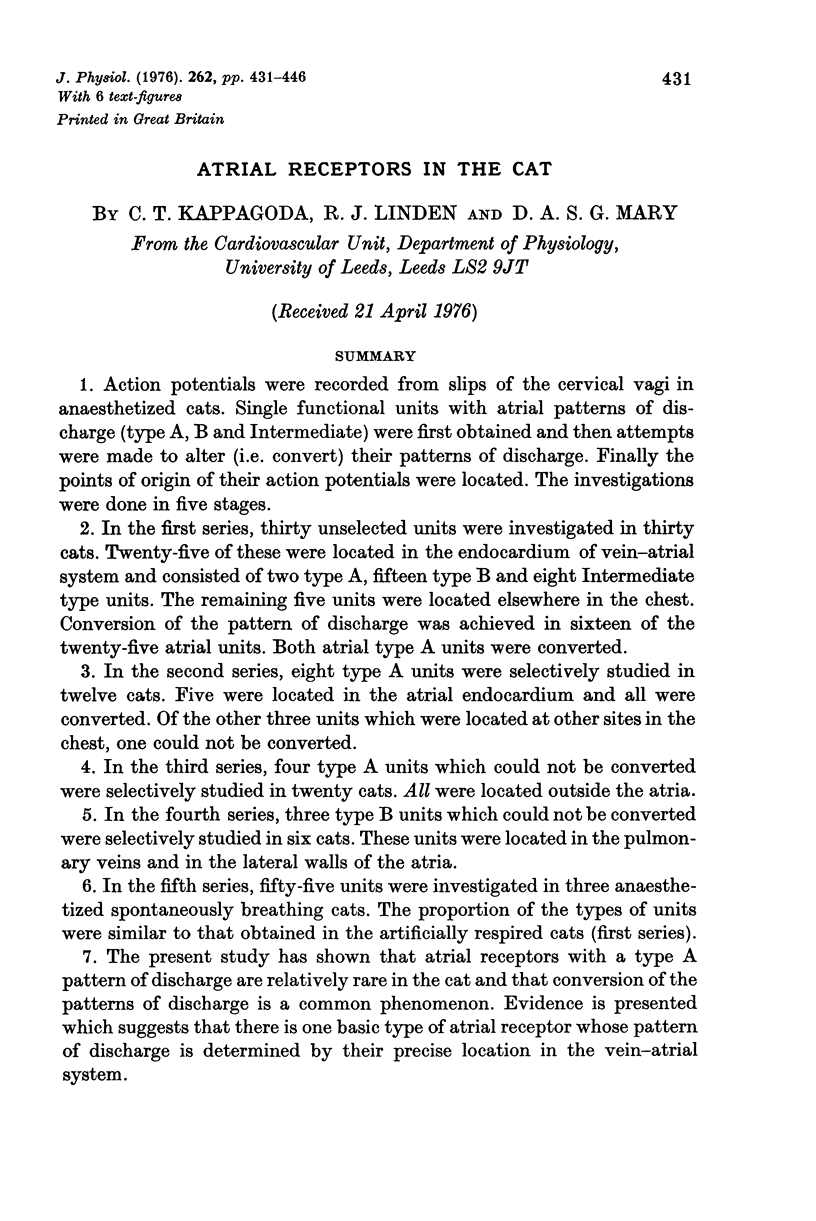Abstract
Action potentials were recorded from slips of the cervical vagi in anaesthetized cats. Single functional units with atrial patterns of discharge (type A, B and Intermediate) were first obtained and then attempts were made to alter (i.e. convert) their patterns of discharge. Finally the points of origin of their action potentials were located. The investigations were done in five stages. 2. In the first series, thirty unselected units were investigated in thirty cats. Twenty-five of these were located in the endocardium of vein-atrial system and consisted of two type A, fifteen type B and eight Intermediate type units. The remaining five units were located elsewhere in the chest Conversion of the pattern of discharge was achieved in sixteen of the twenty-five atrial units. Both atrial type A units were converted. 3. In the second series, eight type A units were selectively studied in twelve cats. Five were located in the atrial endocardium and all were converted. Of the other three units which were located at other sites in the chest, one could not be converted. 4. In the third series, four type A units which could not be converted were selectively studied in twenty cats. All were located outside the atria. 5. In the fourth series, three type B units which could not be converted were selectively studied in six cats. These units were located in the pulmonary veins and in the lateral walls of the atria. 6. In the fifth series, fifty-five units were investigated in three anaesthetized spontaneously breathing cats. The proportion of the types of units were similar to that obtained in the artificially respired cats (first series). 7. The present study has shown that atrial receptors with a type A pattern of discharge are relatively rare in the cat and that conversion of the patterns of discharge is a common phenomenon. Evidence is presented which suggests that there is one basic type of atrial receptor whose pattern of discharge is determined by their precise location in the vein-atrial system.
Full text
PDF















Selected References
These references are in PubMed. This may not be the complete list of references from this article.
- Arndt J. O., Brambring P., Hindorf K., Röhnelt M. The afferent discharge pattern of atrial mechanoreceptors in the cat during sinusoidal stretch of atrial strips in situ. J Physiol. 1974 Jul;240(1):33–52. doi: 10.1113/jphysiol.1974.sp010597. [DOI] [PMC free article] [PubMed] [Google Scholar]
- COLERIDGE J. C., HEMINGWAY A., HOLMES R. L., LINDEN R. J. The location of atrial receptors in the dog: a physiological and histological study. J Physiol. 1957 Apr 3;136(1):174–197. doi: 10.1113/jphysiol.1957.sp005750. [DOI] [PMC free article] [PubMed] [Google Scholar]
- GRIBBE P., LIND J., LINKO E., WEGELIUS C. The events of the left side of the normal heart as studied by cineradiography. Cardiologia. 1958;33(4):293–304. doi: 10.1159/000166350. [DOI] [PubMed] [Google Scholar]
- Gilmore J. P., Zucker I. H. Discharge of type B atrial receptors during changes in vascular volume and depression of atrial contractility. J Physiol. 1974 Jun;239(2):207–223. doi: 10.1113/jphysiol.1974.sp010564. [DOI] [PMC free article] [PubMed] [Google Scholar]
- KJELLBERG S. R., OLSSON S. E. Roentgenologic studies of the sphincter mechanism of the caval and pulmonary veins. Acta radiol. 1954 Jun;41(6):481–497. doi: 10.3109/00016925409170692. [DOI] [PubMed] [Google Scholar]
- Kappagoda C. T., Linden R. J., Snow H. M. The effect of stretching the superior vena caval-right atrial junction on right atrial receptors in the dog. J Physiol. 1972 Dec;227(3):875–887. doi: 10.1113/jphysiol.1972.sp010063. [DOI] [PMC free article] [PubMed] [Google Scholar]
- LIND J., WEGELIUS C. The relationship between electrical and mechanical events in the heart as demonstrated by angiocardiography. Med Bull (Ann Arbor) 1956 Oct;22(10):447–463. [PubMed] [Google Scholar]
- NEIL E., JOELS N. The impulse activity in cardiac afferent vagal fibres. Naunyn Schmiedebergs Arch Exp Pathol Pharmakol. 1961;240:453–460. doi: 10.1007/BF00244938. [DOI] [PubMed] [Google Scholar]
- Oberg B., Thorén P. Increased activity in left ventricular receptors during hemorrhage or occlusion of caval veins in the cat. A possible cause of the vaso-vagal reaction. Acta Physiol Scand. 1972 Jun;85(2):164–173. doi: 10.1111/j.1748-1716.1972.tb05247.x. [DOI] [PubMed] [Google Scholar]
- PAINTAL A. S. A study of right and left atrial receptors. J Physiol. 1953 Jun 29;120(4):596–610. doi: 10.1113/jphysiol.1953.sp004920. [DOI] [PMC free article] [PubMed] [Google Scholar]
- PAINTAL A. S. VAGAL AFFERENT FIBRES. Ergeb Physiol. 1963;52:74–156. [PubMed] [Google Scholar]
- Paintal A. S. Vagal sensory receptors and their reflex effects. Physiol Rev. 1973 Jan;53(1):159–227. doi: 10.1152/physrev.1973.53.1.159. [DOI] [PubMed] [Google Scholar]
- Rao P. S., Fahim M., Gupta B. N. Relative distribution of types A and B atrial receptors in dogs, cats, monkeys and rabbits. Experientia. 1975 Oct 15;31(10):1174–1175. doi: 10.1007/BF02326777. [DOI] [PubMed] [Google Scholar]
- Recordati G. Proceedings: Responses of type A atrial vagal receptors to changes in atrial dynamics. J Physiol. 1975 Sep;251(1):36P–37P. [PubMed] [Google Scholar]
- Whitteridge D. Afferent nerve fibres from the heart and lungs in the cervical vagus. J Physiol. 1948 Sep 30;107(4):496–512. doi: 10.1113/jphysiol.1948.sp004294. [DOI] [PMC free article] [PubMed] [Google Scholar]


